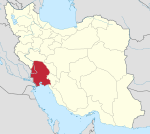Ahvaz
Ahvaz (Persian: ![]()
Ahvâz اهواز | |
|---|---|
City | |
   .jpg)  From top: Ahvaz City at night, The white bridge, the eighth bridge, the triangle building of Shahid Chamran University, the shrine of Ali ibn Mahziar, Karun river, and black bridge, . | |
 Seal | |
| Nickname(s): The City of Bridges | |
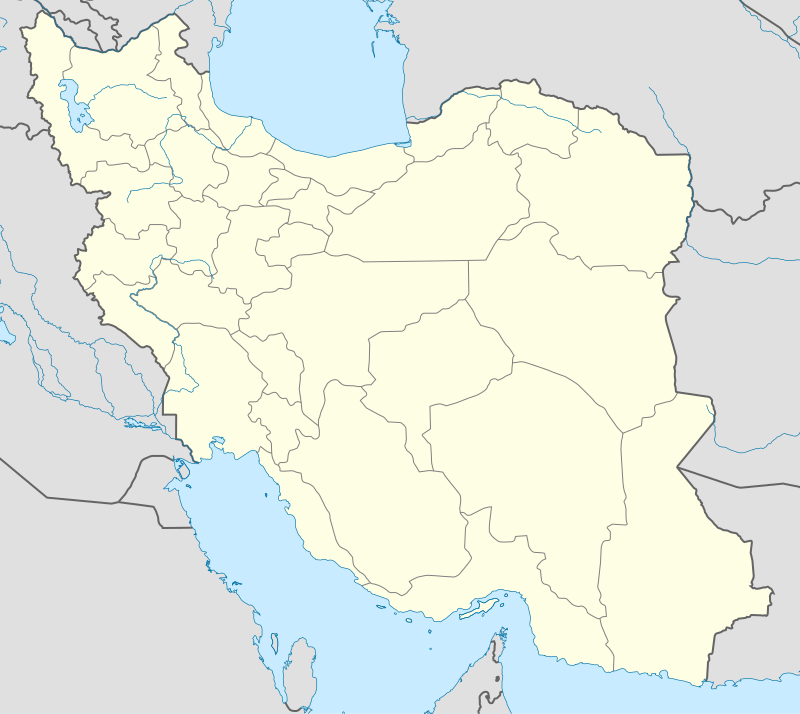 Ahvâz | |
| Coordinates: 31°19′13″N 48°40′09″E | |
| Country | |
| Province | Khuzestan |
| County | Ahvaz |
| Bakhsh | Central |
| Government | |
| • Mayor | Mosa shaere karemy |
| Area | |
| • City | 185 km2 (71 sq mi) |
| Elevation | 17 m (52 ft) |
| Population (2016 Census) | |
| • Urban | 1,350,000[1] |
| • Metro | 1,410,000 |
| Demonym(s) | Ahvazi |
| Time zone | UTC+3:30 (IRST) |
| • Summer (DST) | UTC+4:30 (IRDT) |
| Postal code | 61xxx |
| Area code(s) | (+98) 61 |
| Climate | BWh |
| Website | www |
Iran's only navigable river, the Karun, passes by the middle of the city.[5] It has a long history dating back to the Achaemenid period. In ancient times, it was one of the main centers of the Academy of Gondishapur.
Etymology
The word Ahvaz is a modern Persianized form of the Arabic "Ahwaz" which in turn, is derived from an older Persian word. The Dehkhoda Dictionary specifically defines the "Suq-al-Ahvaz" as "Market of the Khuzis", where "Suq" is the Elamite word for market, and "Ahvaz" is a broken plural (اسم جمع) of the form "af'āl" (افعال) of the word "Huz", which itself comes from the Persian Huz, from Achaemenid inscriptions where the term first appears. Thus, "Ahvaz" in Persian means "the Huz-i people", which refers to the Khuzi original inhabitants of Khūzestān.
The name of the region appears in medieval Syriac sources as ܒܝܬ ܗܘܙܝܐ Beṯ Huzáyé, literally meaning "land of the Huzis".[6]
The term "Huz", meanwhile, is the Old Persian rendition of Suz (Susa-Susiana), the native Elamite name of the region. See Origin of the name Khuzestan and Elam#Etymology for more details.
History
Ancient history
Ahvaz is the analog of "Avaz" and "Avaja" which appear in Darius's epigraph. This word appears in Naqsh-Rostam inscription as "Khaja" or "Khooja" too.
First named Ōhrmazd-Ardašēr (Persian: هرمزداردشیر Hormizdartazir)[7] it was built near the beginning of the Sassanid dynasty on what historians believe to have been the site of the old city of Taryana, a notable city under the Persian Achaemenid dynasty, or the city of Aginis referred to in Greek sources[8] where Nearchus and his fleet entered the Pafitigris.. It was founded either by Ardashir I in 230 (cf. Encyclopædia Iranica, al-Muqaddasi, et al.) or (according to the Middle Persian Šahrestānīhā ī Ērānšahr) by his grandson Hormizd I; the cities name either combined Ardashir's name with the Zoroastrian name for God, Ōhrmazd or Hormizd's name with that of his grandfather. It became the seat of the province, and was also referred to as Hūmšēr. During the Sassanid era, an irrigation system and several dams were constructed, and the city prospered. Examples of Sassanid-era dams are Band-e Bala-rud, Band-e Mizan, Band-e Borj Ayar and Band-e Khak. The city replaced Susa, the ancient capital of Susiana, as the capital of what was then called Khuzestān.
The city had two sections; the nobles of the city lived in one part while the other was inhabited by merchants.[9] When the Arabs invaded the area in 640, the part of the city home to the nobility was demolished but the Hūj-ī-stānwāčār "Market of Khūz State", the merchant area, remained intact. The city was therefore renamed Sūq al-Ahwāz, "Market of the Khuz", a semi-literal translation of the Persian name of this quarter - Ahwāz being the Arabic broken plural of Hûz, taken from the ancient Persian term for the native Elamite peoples, Hūja (remaining in medieval khūzīg "of the Khuzh" and modern Khuzestān "Khuz State", as noted by Dehkhoda dictionary).
Medieval history
During the Umayyad and Abbasid eras, Ahvaz flourished as a center for the cultivation of sugarcane and as the home of many well-known scholars. It is discussed by such respected medieval historians and geographers as ibn Hawqal, Tabari, Istakhri, al-Muqaddasi, Ya'qubi, Masudi, and Mostowfi Qazvini. Nearby stood the Academy of Gundishapur, where the modern-day teaching hospital is said to have been first established.
Ahvaz was devastated in the Mongol invasions of the 13th and 14th centuries and subsequently declined into a village. The dam and irrigation channels, no longer maintained, eroded and finally collapsed early in the 19th century. During this time Ahvaz was primarily inhabited by the original Khuzhis and a small number of Sabians. Although most Arab migrants fled the city, a few stayed. Some minor cultivation continued, while all evidence of sugarcane plantations is still going on in Haft Teppe area in north of Ahvaz, although ruins of sugarcane mills from the medieval era remained in existence.[10] Several ruins of water mills also still remain in Shush and Shushtar.
Modern history
The seat of the province has, for the most of its history, been in its northern reaches, first at Susa (Shush) and then at Shushtar. During a short spell in the Sasanian era, the capital of the province was moved to its geographical center, where the river town of Hormuz-Ardashir (modern Ahvaz). However, later in the Sasanian time and throughout the Islamic era, the provincial seat returned and stayed at Shushtar, until the late Qajar period. With the increase in the international sea commerce arriving on the shores of Khuzestan, Ahvaz became a more suitable location for the provincial capital. The River Karun is navigable all the way to Ahvaz (above which, the Karun flows through rapids). The town was thus refurbished by the order of the Qajar king, Naser al-Din Shah and renamed after him, Nâseri. Shushtar quickly declined, while Ahvaz/Nâseri prospered to the present day.
In the 19th century, "Ahvaz was no more than a small borough inhabited mainly by Sabeans (1,500 to 2,000 inhabitants according to Ainsworth in 1835; 700 according to Curzon in 1890)."[11]
In the 1880s, under Qajar rule, the Karun River was dredged and re-opened to commerce. A newly built railway crossed the Karun at Ahvaz. The city again became a commercial crossroads, linking river and rail traffic. The construction of the Suez Canal further stimulated trade. A port city was built near the old village of Ahvaz, and named Bandar-e-Naseri in honor of Nassereddin Shah Qajar.
Oil was found near Ahvaz in the early 20th century, and the city once again grew and prospered as a result of this newfound wealth. From 1897–1925, the city of Ahvaz was in the hands of heshmatoddoleh Ghajar, who acted as governor and Sarhang Reza Gholi Khane Arghoon commander of Ghajari's army based in Khuzestan. Sheikh Khaz'al was recognized by Mozaffar ad-Din Shah Qajar as hereditary ruler of Mohammerah, Sardar Asad Bakhtiari as the most powerful leader of Khuzestan's Bakhtiaries. He had power and authority over most regions of Khuzestan, such as Dezful, Shushtar, Izeh, even Ahvaz and Amir mojahede bakhtiari in Ramhormoz and Behbahan. At this time, the newly founded Ahvaz was named Nâseri in honour to its founder Nassereddin Shah Qajar. Afterwards, during the Pahlavi period, it resumed its old name, Ahvaz. The government of the Khūzestān Province was transferred there from Shûshtar in 1926. The Trans-Iranian Railway reached Ahvaz in 1929 and by World War II, Ahvaz had become the principal built-up area of the interior of Khūzestān. Professional segregation remained well marked between various groups in that period still feebly integrated: Persians, sub-groupings of Persians and Arabs. Natives of the Isfahan region held an important place in retail trade, owners of cafes and hotels and as craftsmen.[12]
Iraq attempted to annex Khūzestān and Ahvaz in 1980, resulting in the Iran–Iraq War (1980–1988). Ahvaz was close to the front lines and suffered badly during the war.
Iraq had pressed its claims to Khūzestān. Iraq had hoped to exacerbate ethnic tensions and win over popular support for the invaders. Most accounts say that the Iranian Arab inhabitants resisted the Iraqis rather than welcome them as liberators. However, some Iranian Arabs claim that as a minority they face discrimination from the central government; they agitate for the right to preserve their cultural and linguistic distinction and more provincial autonomy. See Politics of Khūzestān.
In 1989, the Foolad Ahvaz steel facility was built close to the town. This company is best known for its company-sponsored football club, Foolad F.C., which was the champion of Iran's Premier Football League in 2005.
In 2005 the city witnessed a series of bomb explosions. Many government sources relate these events to developments in Iraq, accusing foreign governments of organizing and funding Arab separatist groups. The Arab Struggle Movement for the Liberation of Ahvaz claimed credit for several of the bombings, including four bombs on 12 June 2005, that killed 8 people.[13]
Gunmen killed at least 29 people in an attack on a crowd watching a military parade on 22 September 2018.[14]
Bridges
Ahvaz has 9 Bridges Over Karun.[15]
Pol-e Siah (Black Bridge)
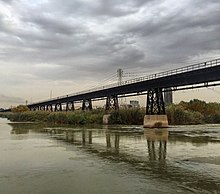
Black Bridge,Also Known as Victory Bridge,Is the First Bridge over of Ahvaz.The Bridge used in WWII to supply Allies in Soviet Union and it had a vast impact in Allies victory.[16]
White Bridge

White Bridge (Persian: پل سفید), is an arch bridge located in Ahwaz, Iran. The bridge was completed on September 21, 1936 and was inaugurated on November 6, 1936. The bridge remains a symbol of the city still today.
Location and roads
Ahvaz located 100 km north-east of Abadan and is accessible via following routes in addition of a single runway airport:
- Tehran-Khorramshahr national railway



Ahvaz, being the largest city in the province, consists of two distinctive districts: the newer part of Ahvaz which is the administrative and industrial center, which is built on the right bank of the Karun river while residential areas are found in the old section of the city, on the left bank.
Climate
Ahvaz has a subtropical hot desert climate (Köppen climate classification BWh) with long, hot summers and cool, short winters. Summer temperatures are regularly at least 45 °C (113 °F) sometimes exceeding 50 °C (122 °F)[17] with many sandstorms and duststorms common during the summer period. However, in winters, the minimum temperature can fall to around 5 °C (41 °F). Winters in Ahvaz have no snow. The average annual rainfall is around 230 mm. On June 29, 2017, the temperature reached 50 °C (122 °F). Furthermore, the dew point peaks 23 °C (73 °F) which is unusually humid for the usual dry heat. Despite the fact that it has never snowed in Ahvaz, it has fallen down to -7 degrees Celsius before.
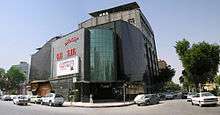
| Climate data for Ahvaz (1951–2010) | |||||||||||||
|---|---|---|---|---|---|---|---|---|---|---|---|---|---|
| Month | Jan | Feb | Mar | Apr | May | Jun | Jul | Aug | Sep | Oct | Nov | Dec | Year |
| Record high °C (°F) | 28.0 (82.4) |
31.5 (88.7) |
37.6 (99.7) |
43.0 (109.4) |
48.6 (119.5) |
51.0 (123.8) |
54.0 (129.2) |
51.6 (124.9) |
48.4 (119.1) |
45.0 (113.0) |
36.0 (96.8) |
29.0 (84.2) |
54.0 (129.2) |
| Average high °C (°F) | 17.5 (63.5) |
20.5 (68.9) |
25.5 (77.9) |
32.2 (90.0) |
39.3 (102.7) |
44.6 (112.3) |
46.3 (115.3) |
45.9 (114.6) |
42.5 (108.5) |
36.0 (96.8) |
26.5 (79.7) |
19.4 (66.9) |
33.0 (91.4) |
| Daily mean °C (°F) | 12.3 (54.1) |
14.7 (58.5) |
19.0 (66.2) |
24.9 (76.8) |
31.1 (88.0) |
35.2 (95.4) |
37.3 (99.1) |
36.7 (98.1) |
33.0 (91.4) |
27.3 (81.1) |
19.8 (67.6) |
14.0 (57.2) |
25.4 (77.7) |
| Average low °C (°F) | 7.2 (45.0) |
8.8 (47.8) |
12.5 (54.5) |
17.6 (63.7) |
23.0 (73.4) |
25.9 (78.6) |
28.2 (82.8) |
27.4 (81.3) |
23.4 (74.1) |
18.8 (65.8) |
13.0 (55.4) |
8.6 (47.5) |
17.9 (64.2) |
| Record low °C (°F) | −7.0 (19.4) |
−5.0 (23.0) |
−1.0 (30.2) |
6.0 (42.8) |
13.0 (55.4) |
15.0 (59.0) |
19.0 (66.2) |
18.0 (64.4) |
13.0 (55.4) |
8.0 (46.4) |
0.0 (32.0) |
−1.0 (30.2) |
−7.0 (19.4) |
| Average precipitation mm (inches) | 48.2 (1.90) |
26.9 (1.06) |
26.4 (1.04) |
16.1 (0.63) |
4.4 (0.17) |
0.4 (0.02) |
0.1 (0.00) |
0.0 (0.0) |
0.2 (0.01) |
6.4 (0.25) |
31.4 (1.24) |
48.7 (1.92) |
209.2 (8.24) |
| Average precipitation days (≥ 1.0 mm) | 4.9 | 3.6 | 3.6 | 2.8 | 0.8 | 0.1 | 0.0 | 0.0 | 0.0 | 1.0 | 2.9 | 4.5 | 24.2 |
| Average relative humidity (%) | 71 | 61 | 51 | 41 | 28 | 22 | 24 | 28 | 29 | 38 | 53 | 69 | 43 |
| Mean monthly sunshine hours | 174.7 | 193.2 | 214.1 | 233.8 | 284.4 | 326.2 | 336.1 | 331.2 | 301.8 | 263.5 | 209.5 | 176.4 | 3,044.9 |
Source: Iran Meteorological Organization (records),[18] (temperatures),[19]
| |||||||||||||
People
| Year | Pop. | ±% p.a. |
|---|---|---|
| 1986 | 579,826 | — |
| 1991 | 724,653 | +4.56% |
| 1996 | 804,980 | +2.12% |
| 2006 | 985,614 | +2.05% |
| 2011 | 1,112,021 | +2.44% |
| 2016 | 1,184,788 | +1.28% |
| source:[24] | ||
According to the 2016 census, the city had an estimated population of 1.1 million people.[25]
Languages
Based on a survey taken by the Iranian ministry of culture in 2010, the most common languages in Ahvas are Persian (44.8%), Arabic (35.7%), and Bakhtiari (15.8%).[26] Many Ahvazis are bilingual, speaking both Persian and one of the following languages/Dialects. The indigenous inhabitants of Ahvaz speak Khuzestani Persian dialect that is unique to Khuzestan, and rooted in old Persian and Elamite languages. The Arabic spoken in Ahvas is a variety of Khuzestani Arabic.[27][28][29] Another part of Ahvazis speak Bakhtiari dialect of Luri language.[30][31][32] Modern Mandaic (or Mandaee) language is also spoken among the Mandaeans of Ahvaz. It is the ancient Mandaic language mingled by some aspect of Khuzi.
Pollution
In 2011, the World Health Organization ranked Ahvaz as the world's most air-polluted city.[33] The reason Ahvaz is so polluted is because of its oil industry. The pollution can be very dangerous, causing different types of diseases and harmful to plants.[34]
Transportation
Airport
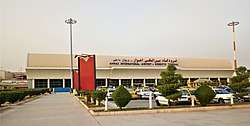
Ahvaz International Airport (IATA: AWZ, ICAO: OIAW) (Persian: فرودگاه بینالمللی اهواز) is an airport serving the city of Ahvaz, Iran.
Railway

Ahwaz railway station (Persian:ايستگاه راه آهن اهواز, Istgah-e Rah Ahan-e Ahvaz) is located in Ahvaz, Khuzestan Province.
- Ahvaz is accessible via freeways from Isfahan and Shiraz, and roadways to Tehran.
- A metro urban railway system is being built by the Ahvaz urban railway. The system is planned to have a total of four lines. Line 1 will be a 23 km underground line with 24 stations.[36]
Sport
Traditionally, Khuzestan province has been a major soccer hub in Iran. The city has two existing sport complexes: Takhti Stadium and the newly constructed Ghadir Stadium. There are several other smaller complexes for martial arts, swimming pools and gymnasiums. Also, a new privately owned stadium is currently under construction by Foolad F.C. in Ahvaz.
Sajjad Gharibi (born 19 December 1991) is an Iranian bodybuilder. [37][38] He born on Ahwaz, and has lived in Busher. He has become famous in world because of his special physique. His musculus volume is extraordinary for his height, 186 cm (6'2" tall), and weight, 180 kg (390 lb). He has looked like The Incredible Hulk character, because of his size, his Iranian fans have called him Iranian Hulk.[39]
Football
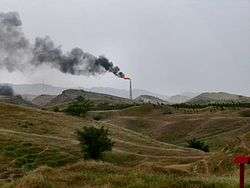
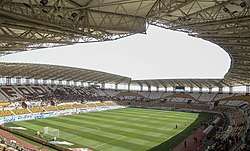
Football is a major part of the city's culture. The abundant enthusiasm has made Ahvaz home to three Iranian major Football clubs: Foolad, Esteghlal Khuzestan are currently playing in the Persian Gulf Pro League, and Esteghlal Ahvaz is playing in Azadegan League.
Foolad have won the league on two occasions, the 2013–2014 season and the 2004–2005 season. Esteghlal Ahvaz finished runners–up in the league in the 2006–2007 season. In 2016, Esteghlal Khuzestan won the league for the first time.
A number of other teams such as Foolad B the second team of Foolad and Karun Khuzestan play in the 2nd Division.
Futsal
Ahvaz has also two teams in the Iranian Futsal Super League, which are Sherkat Melli Haffari Iran FSC and Gaz Khozestan FSC.
Colleges and universities
Ahvaz is also known for its universities as well as its role in commerce and industry. Ahvaz institutes of higher learning include:
- Ahvaz Jundishapur University of Medical Sciences
- Petroleum University of Technology
- Shahid Chamran University of Ahvaz
- Islamic Azad University of Ahvaz
Notable people
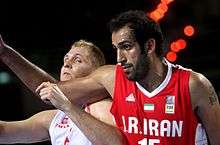
- Ali Sajadi Hoseini, filmmaker
- Ali Shamkhani, Iranian Minister of Defense (1997–2005)
- Amir Taheri, Iranian conservative author
- Ahmad Mahmoud, Persian novelist
- Amirreza Amirbakhtiar, political activist
- Ezzat Negahban, patriarch of modern Iranian archaeology
- Hamed Haddadi, NBA basketball player
- Hamid Dabashi, intellectual historian, cultural and literary critic
- Hamid Zangeneh, economist, author, and activist
- Hossein Kaebi, national football player
- Jalal Kameli Mofrad, national football player
- Mehrangiz Kar, human rights activist
- Mohammad Ali Mousavi Jazayeri, former Wali-Faqih representative in Khuzestan, former Ahwaz Friday Imam
- Mohammad Hossein Adeli, Iranian Economist and Diplomat
- Mohammad-Reza Eskandari, Iran's former minister of Agriculture
- Muhammad ibn Falah, theologian
- Parviz Abnar, Iranian Sound recordist
- Patrick Monahan, British comedian
- Manuchehr Shahrokhi, Professor of Finance, California State University; Editor, Global Finance Journal; Executive Director, Global Finance Association-Conference
- Saman Kojuri, voice actor, radio and TV host
- Sousan S. Altaie, PhD Scientific Policy Advisor, OIVD CDRH, FDA
Gallery
 Rumi statue located in the front of the faculty of letters and humanities of the Shahid Chamran University of Ahvaz
Rumi statue located in the front of the faculty of letters and humanities of the Shahid Chamran University of Ahvaz The Qadir Bridge
The Qadir Bridge White Bridge over Karun river
White Bridge over Karun river
See also
- Ahvaz Field
- Choqa Zanbil
- Elam
- Gundeshapur
- History of Iran
- Khūzestān Province
- Mandaeism, Mandaic language
- Politics of Khūzestān
- Susa
- Takhti Stadium (Ahvaz)
- Rahian-e Noor
References
- "Statistical Center of Iran > Home". www.amar.org.ir.
- Public statistics of population and housing amar.org.ir 5 May 2018
- Getting know to Ahwaz aparat.com Retrieved 5 May 2018
- AbdulHussain Sa'dian, Land and people of Iran, Anthropologyand ceremonies of Iranian ethnicities, publishers science and life, P. 463-463
- "Khuzestan (Iran): Counties & Cities - Population Statistics, Charts and Map". www.citypopulation.de.
- Bar Bahlul, Hasan. "Bar Bahlul Dictionary". Retrieved 1 February 2012.
- Dodgeon M. H. and Lieu S. N. C., The Roman Eastern Frontier and The Persian Wars; A Documentary History, London (1991), p.35; ISBN 0-415-10317-7
- "Ahvaz". toiran.com. Retrieved 2015-04-23.
- cf. Encyclopædia Iranica
- X. de Planhol, Encyclopædia Iranica
- Encyclopædia Iranica, p.690, see entry: Ahvaz
- Ibid, p.690
- Arab Struggle Movement for the Liberation of Ahwaz MIPT Terror Knowledge Base
- "29 killed, 60 injured in Iran military parade attack on Revolutionary Guards". english.alarabiya.net.
- "اهواز", ویکیپدیا، دانشنامهٔ آزاد (in Persian), 2020-07-20, retrieved 2020-07-20
- "پل سیاه اهواز / پل پیروزی در مسیر تاریخ + گزارش تصویری". web.archive.org. 2015-03-22. Retrieved 2020-07-20.
- "Where is the world's hottest city?". the Guardian. Retrieved 3 March 2016.
-
- "Highest record temperature in Ahwaz by Month 1951–2010". Iran Meteorological Organization. Retrieved April 8, 2015.
- "Lowest record temperature in Ahwaz by Month 1951–2010". Iran Meteorological Organization. Retrieved April 8, 2015.
-
- "Average Maximum temperature in Ahwaz by Month 1951–2010". Iran Meteorological Organization. Archived from the original on May 26, 2016. Retrieved April 8, 2015.CS1 maint: BOT: original-url status unknown (link)
- "Average Mean Daily temperature in Ahwaz by Month 1951–2010". Iran Meteorological Organization. Retrieved April 8, 2015.
- "Average Minimum temperature in Ahwaz by Month 1951–2010". Iran Meteorological Organization. Archived from the original on May 30, 2016. Retrieved April 8, 2015.CS1 maint: BOT: original-url status unknown (link)
- "Monthly Total Precipitation in Ahwaz by Month 1951–2010". Iran Meteorological Organization. Retrieved April 8, 2015.
- "Average relative humidity in Ahwaz by Month 1951–2010". Iran Meteorological Organization. Archived from the original on May 26, 2016. Retrieved April 8, 2015.CS1 maint: BOT: original-url status unknown (link)
- "No. Of days with precipitation equal to or greater than 1 mm in Ahwaz by Month 1951–2010". Iran Meteorological Organization. Archived from the original on March 4, 2016. Retrieved April 8, 2015.CS1 maint: BOT: original-url status unknown (link)
- "Monthly total sunshine hours in Ahwaz by Month 1951–2010". Iran Meteorological Organization. Archived from the original on March 5, 2016. Retrieved April 8, 2015.CS1 maint: BOT: original-url status unknown (link)
- "Iran: Provinces, Major Cities & Towns - Population Statistics, Maps, Charts, Weather and Web Information". www.citypopulation.de.
- population amar.org.ir
- فهرست نویسی پیش از انتشار کتابخانه ملی جمهوری اسلامی ایران * شماره کتاب شناسه ملّی:۲۸۹۰۶۹۰ *عنوان و نام پدیدآورنده:طرح بررسی و سنجش شاخصهای فرهنگ عمومی کشور (شاخصهای غیرثبتی){گزارش}:گزارشهای پیشرفت طرحها وکلان شهرها/به سفارش شورای فرهنگ عمومی کشور؛ مدیر طرح و مسئول سیاست گذاری:منصور واعظی؛ اجرا:شرکت پژوهشگران خبره پارس *بهاء:۱۰۰۰۰۰ ریال-شابک:۷-۶۸-۶۶۲۷-۶۰۰-۹۷۸ *وضعیت نشر:تهران-مؤسسه انتشارات کتاب نشر ۱۳۹۱ *وضعیت ظاهری:۲۹۵ ص:جدول (بخش رنگی)، نمودار (بخش رنگی)*یادداشت:عنوان دیگر:طرح و بررسی و سنجش شاخصهای فرهنگ عمومی کشور (شاخصهای غیرثبتی) سال ۱۳۸۹ *توصیفگر:شاخصهای غیرثبتی+شاخصهای فرهنگی+گزارشهای پیشرفت طرحها و کلانشهرها *توصیفگر:ایران ۳۸۶۲۸۹ *تهران۱۹۹۰۶۶ /مشهد۲۹۲۳۴۱ /اصفهان ۱۷۰۰۱۷/تبریز۱۸۴۸۱/کرج ۲۷۸۲۵۲/شیراز۲۵۱۷۰۳/اهواز۱۷۶۴۰۳/قم۲۷۰۸۷۷ *شناسنامه افزوده:واعظی، منصور، ۱۳۳۳–۷۳۵۰۶۸ *شناسنامه افزوده:شرکت پژوهشگران خبره پارس /شورای فرهنگ عمومی *مرکز پخش:خیابان ولیعصر، زرتشت غربی، خیابان کامبیز، بخش طباطبایی رفیعی، پلاک۱۸، تلفن:۷–۸۸۹۷۸۴۱۵ *لیتوگرافی، چاپ و صحافی:سازمان چاپ و انتشارات اوقاف
- Iranian Arabs parsine.com Retrieved 24 June 2018
- Khuzestani Arabs aparat.com Retrieved 24 June 2018
- Khuzestani Arabic isna.ir Retrieved 24 June 2018
- Bakhtiari tribes kojaro.com
- Bakhtiari Archived 2018-07-25 at the Wayback Machine aparat.com
- Arab Kamari/Arab-Bakhtiari Archived 2018-07-24 at the Wayback Machine rangvarehayeyekrang.ir
- Walsh, Bryan (27 September 2011). "The 10 Most Air-Polluted Cities in the World". Time. Retrieved 2012-02-25.
- "Pollution". Ahwaz, Iran. Retrieved 2017-09-21.
- Changing the name of Ahwaz international Airport to "Martyr Major-General Haj Qasem Soleimani" iribnews.ir Retrieved 27 March 2020
- Ahwaz Urban & Suburban Railway Organization (in Persian)
- "'Scariest Man On The Planet' to fight 'Iranian Hulk' in MMA debut". talksport. 22 November 2018. Retrieved 25 May 2019.
- "178kg monster is an absolute weapon". news.com.au. 23 November 2018. Retrieved 25 May 2019.
- "همه چیز درباره چهره شاخص این روزهای فضای مجازی". tasnimnews.com. Tasnimnews. 31 May 2016. Retrieved 25 May 2019.
- "Soot - Cancer-Causing Substances - National Cancer Institute". www.cancer.gov. March 20, 2015.
- The stadium of "Foolad Khuzestan martyrs" yjc.ir Retrieved 20 January 2020
External links
| Wikivoyage has a travel guide for Ahvaz. |
| Wikimedia Commons has media related to Ahvaz. |
- Foolad Ahvaz Football Club (in Persian)


